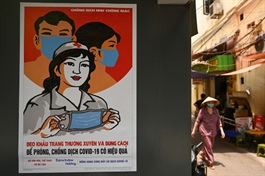Necessary to have long term debt payment policy
Necessary to have long term debt payment policy
By the end of 2020, public debt will be about 56.8% of GDP, government debt will be about 50.8% of GDP, and the direct debt repayment obligation compared to estimated state budget revenue will be 24.1%.
Illustrative photo.
|
However, by 2021, the debt ratio will increase when the Government sets out to raise government loans to balance the budget, including loans to offset a budget deficit, and loans to pay the principal debt of the budget.
Public debt payment policy
According to a representative from the Department of Debt Management and External Finance under the Ministry of Finance, between 2016 to 2020, public debt management was strengthened and basically met the set targets. Specifically, the target of low-cost capital mobilization associated with reasonable risks for investment in socio-economic development, restructuring of public debt, ensuring safety of public debts, and national financial security were dealt with.
From there, the Government also built public debt safety indicators, ensuring that macro-economic stability was not broken, on basis of reporting fully and accurately the plan of borrowing and repaying public debt in the period 2021 until 2025. Currently, Vietnam ranks 113th in the world in terms of public debt to GDP, 68th in public debt per capita, and 36th in GDP. According to Moody's assessment, the level of public debt per capita in Vietnam is average.
By 2021, the debt ratio will increase when the Government sets out to raise government loans to balance the budget for 2021 to about VND 579,000 bn, including loans to offset a budget deficit of around VND 318,000 bn, and loans to pay the principal debt of the budget of about VND 260,000 bn. The pressure to pay public debt is causing much worry to economic experts.
According to Asso. Prof. Dr. Pham The Anh, Chief Economist at the Vietnam Institute for Economic and Policy Research (VEPR), the assessment of ratio of public debt to GDP can cause a gap because GDP cannot be accurately counted. The measure of public debt must be the ratio of public debt to budget revenue, while this number has not decreased but increased because the budget revenue did not increase much. In fact, the debt payment obligation on total budget revenue is approaching the ceiling level allowed by the National Assembly.
Meanwhile, Asso. Prof. Dr. Hoang Van Cuong, a member of the Finance and Budget Committee of the National Assembly, said that what we need to be concerned about is the pressure on public debt repayment obligation that will increase in 2021 because this is the peak year for debt repayment. It is expected that the pressure of public debt in 2021 can reach VND 4,000,000 bn with the rate being pushed up to 63%. Thus, borrowing will be necessary because the revenue can only meet a part of the investment.
Mr. Hoang Van Cuong thinks that if we do not allocate evenly, putting in a time to repay, the debt will increase the burden of repayment for that particular year and lead to difficulties for the Government. He believes, it is therefore necessary to have a long-term public loan and debt repayment policy as public debt ratio is decreasing each year, but the government debt repayment obligation has increased, the reason being that capital mobilization has not been evenly distributed before, leading to different public debt ratios.
Effective control of public investment
According to Asso. Prof. Dr. Hoang Van Cuong, we should not be too afraid of the absolute number of public debt but must look at the issue of public debt in the overall context compared with GDP growth as well as the ability to repay debt. In particular, it is necessary to take into account the ability to repay the public debt, because this is a factor that needs attention instead of just looking at the figure of VND 4,000,000 bn, which does not fully reflect all public debt issues. The crux of the matter is to have good control over loans for efficient investment.
According to the Ministry of Finance, the current structure of public debt is changing with the trend of increased domestic borrowing and reduced foreign borrowing. Government bonds are seen as an effective solution to mobilizing domestic loans as they have been used to invest in the fields of health, transportation, irrigation, public-private-partnership projects (PPP) such as the North-South Expressway. However, the ability to absorb capital in the Government bond market is still limited. Therefore, the issuance of a large amount of capital will put pressure on increasing Government borrowing, or the risk of refinancing in following years, in case the Government has to issue short-term bonds to meet the increasing demand for borrowing.
The implementation of investment stimulus to overcome the economic recession in 2008 to 2009 showed that public investment is boosted to create resources to boost production and business and the economic growth engine. According to calculation by the Ministry of Planning and Investment, if disbursement of public investment capital increases by 1%, GDP will increase by 0.06%. If 100% of the plan for public investment is disbursed in 2020 and nearly VND 700,000 bn is spent, GDP will increase by 0.42%.
Theoretically, the state budget is mainly pumped into loans for direct investment by the Government or transferred to state-owned enterprises, which is often not profitable, therefore increasing public debt with no source for repayment, causing domestic and foreign debt to spiral increasingly. The risk of repayment of due debts along with increasing scale of public debt is a sign of budget insecurity and a public debt crisis. Therefore, public investment needs to reduce state budget and must be invested in profitable projects, ensuring capital recovery.
On the other hand, if disbursement of public investment is delayed, essential works are slowed and the State still has to pay interest, while the contractor has to borrow from the bank, which leads to waste and causes pressure on the government to repay public debt. Therefore, effective public investment disbursement could be the pillar for economic growth in the current Covid-19 pandemic scenario.

























